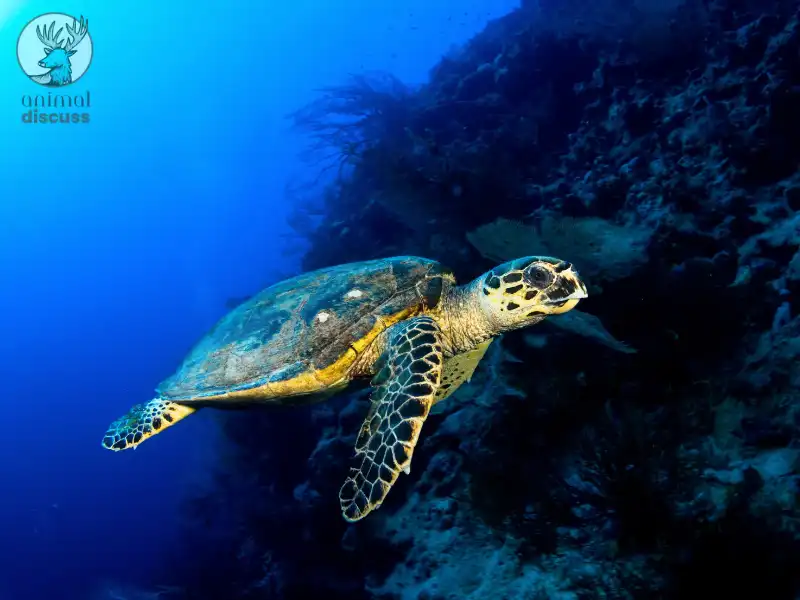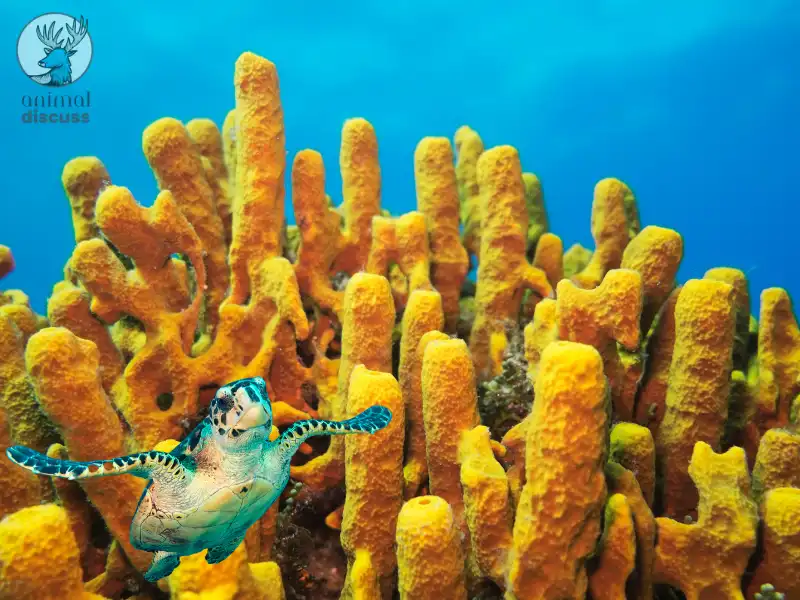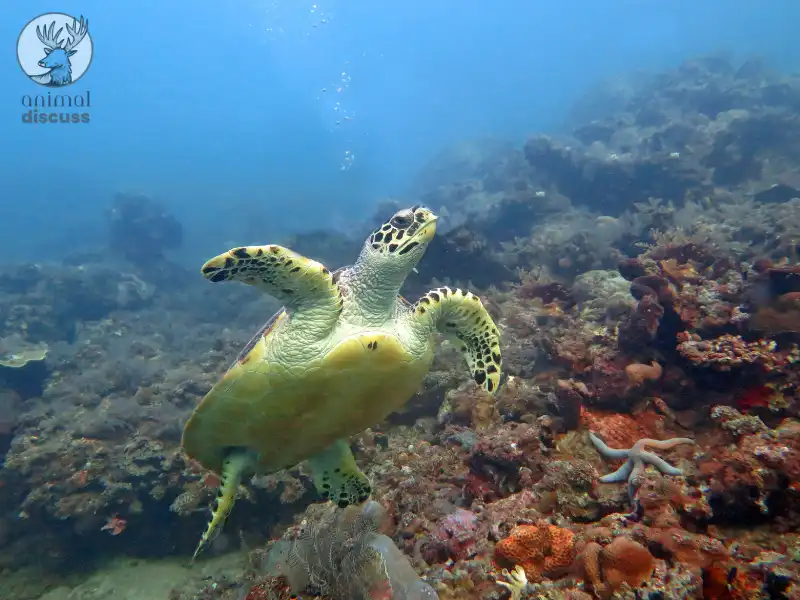Have you ever thought about the delicious food these creatures eat while navigating deeply in the ocean? If not, here is your answer.
Hawksbill sea turtles are mostly spongivores. It means their diet is mainly dependent on sponges. For their unique adaptation process, they face challenges in foraging food. Again, the diet of baby hawksbill sea turtles is slightly different from the adult’s.
Come let’s know more about the food and diet of the hawksbill sea turtle in different sections.
What Do Baby Hawksbill Sea Turtles Eat?
Have you ever thought of having sponges as a meal? Never, right? But the little baby Hawksbill Sea Turtle surprisingly eats them as food.
Unlike adult turtles, these babies have a diverse diet chart in the early stages. In the first stage of their life, they live in the vast open ocean and start life feasting on microscopic organisms.
This helps them to grow strong and provides essential nutrients. But their diet does not stop here! Other diets include –
- Small Hunters: The little turtles munch on small crabs, jellyfish and other fishes that are full of protein.
- Marine meadow: Sea turtles mostly drift with currents; they also choose algae and marine meadows to eat that provide nutrition.
However, as they grow, there is a slight variety noticed in their new diet.
More curious about “Hawksbill Sea Turtle?” Then read details to know more.
What Do Adult Hawksbill Sea Turtles Eat?
Can you recall how the Baby Hawksbill Sea turtle depends on a different variety of food? Now let’s move ahead a few years when their choices change.

When baby turtles become adults, the environment for hunting changes a lot. It transforms them to become sponge experts.
As an adult, Hawksbills develop miraculous resistance to the toxins of sponges. This allows them to eat any toxic animals. It helps them to get food from different and unique types of sources.
Like humans, Hawksbills are also very picky about what they eat. Along with eating sponges, they also eat other reef-dwelling foods. For example,
- Jellyfish
- Mollusks
- Anemones
- Soft corals
- Marine algae
- Corals
- Tunicates
- Crustaceans
- Small fish
- Sea urchins
They take nutrition like protein and vitamins from mussels and different types of snails. Hawksbill also eats sea urchins which are crunchy and nutritious treats.
So, when you meet these amazing creatures, remember their transformation from plankton-eaters to becoming sponge-loving creature.
What Types of Sponges Do They Eat? [Reference]
As now you know sponges are the main food of the hawksbill sea turtle’s unique diet. But they do not consume any kind of sponges that come across them. It’s because of the nutritional value. They hunt sponges that have greater nutrient concentrations that are necessary for their development.
Although they have a tolerance toward toxins, they don’t choose those types of sponges that have excessive toxin levels. Moreover, Hawksbill communities in the Caribbean can often swallow large classes of Porifera that comprise the majority of living sponges. These include Astrophorida, Hadromerida, and Spirophorida.

And here are examples of some specific sponge species that the Hawksbill usually consumes: Aaptos, Chondrilla nucula, Suberites domuncula, and Tethya actinia.
So, it can be said that the hawksbill’s selective eating habit enables maximizing their nutritional value. It is to lower the possibility of consuming dangerous toxins found in many sponge species.
How Do Hawksbill Sea Turtles Forage Their Food?
We know that turtles are one of the slowest animals, right? Accordingly, though Hawksbill Sea turtles appear to be slow, their dedication and ability as foragers are impressive. Mostly in the case of collecting favorite food.
Their strong pointed beak is the most prominent feature they have in them. This pointed beak is ideal for collecting sponges for tight spots and for diving into coral reefs.
Then comes their powerful flippers. The Hawksbills have small powerful flippers. That helps them to swim across currents and navigate around coral structures for food.
And even though the other senses like vision and hearing are not up to the mark, they are thought to be using their sense of smell to find sponges that carry toxins. Likewise, Hawksbills are so picky while choosing their food. Hence, they need to target the right kinds of sponges!
These creatures can recognize different kinds of sponges apart. Then they target particular species according to their toxicity levels and nutritional value.
But you know what! In case their basic diet foods become temporarily unavailable, they immediately modify their eating habits and search for alternatives.
How Does Food Availability for Hawksbill Sea Turtles Vary Across Different Seasons?
Now that you know about the main food supply for hawksbill sea turtles. This doesn’t change with all the seasons but about other food habits as their availability of food varies. It happens because of its specialized food diet.

Hawksbill’s unique diet makes them less dependent on seasonal food. Still, in some cases, indirect impacts are observed in the nesting season.
In the dry season, when the adult female hawksbill lays their eggs, they migrate to specific beaches. This change affects their access to different food. Like, the jellyfish.
What Type of Challenges Do Hawksbill Turtles Face When It Comes To Finding Food?
As humans, we all face challenges in collecting our food. In the same way, Hawksbills also face different challenges, such as
- Internal conflict: When the resources are related, hawksbills compete with one another for food. Younger who are inexperienced foragers find this competition harder than the elders.
- External conflict: Hawksbill competition increases from other marine animals like other sea turtles and fishes.
- Degradation of habitat: Human activity such as overfishing, coastal development and pollution is harming coral reefs. This is also affecting the growth of sponges.
- Limited mobility: Although hawksbills travel large distances, their swimming skill and shell limit their range of motion. This prevents them from accessing more diverse foraging. Specifically, when the local resources start to run low.
- Limitations in senses: Hawksbills find food mostly by using their vision. It makes it difficult for them to collect buried sponges in cloudy waters.
- Defense mechanism system of sponges: Some sponges like toxins and spicules have sharp needle-like structures that make it hard for hawksbill to eat them. Even though hawksbills evolved to overcome these protections, eating these sponges safely still requires a certain set of skills and energy.
Because of these difficulties nowadays, it has become challenging for Hawksbill Sea turtles to collect their food.
Frequently Asked Questions
Here are some frequently asked questions concerning the diet and food of Hawksbill Sea Turtles that I have included below. These are –
01. How does a Hawksbill Sea Turtle usually spend their time foraging?
For 75%-80% of the day, hawksbill turtles use their sharp beaks to dive and search for sponges. But this also varies. Sometimes they become more active in the morning and evening.
02. How many calories does a hawksbill sea turtle eat in a day?
The hawksbill sea turtles consume about 16,000 calories. That is approximately 73% of their body weight. The energy they require comes mostly from sponges.
03. How long can a hawksbill sea turtle go without food?
Hawksbill sea turtles can go for a few weeks or even a month without food. But the age and health of the hawksbill sea turtle play an important role here.
04. Do Hawksbill Sea Turtles drink water?
No, Hawksbill Sea turtles are not like us in the case of drinking water. They get water from the food and also by absorbing saltwater from a gland and then eliminate the excess salt by absorbing it.
Conclusion
The journey to figure out what the hawksbill sea turtle eats is full of surprises. But their diet is not as simple as it seems, right? Their remarkable adaptation process makes them less reliant on seasonal food. Hawksbills are very picky about what they eat. Their diet is mainly dependent on sponges.
They develop miraculous resistance to the toxins of sponges. This allows them to eat any toxic animals. And because they are picky eaters, hawksbills can get the most nutrition out of their food by picking the right sponges. Aside from sponges, they also eat other reefs.

